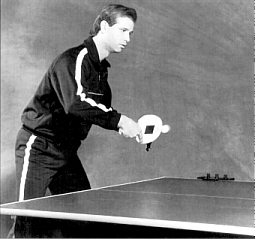|
|
|||||
|
|
|||||
|
|
BACKHAND BLOKExcerpts from Larry Thoman's Newgy Robo-Pong Player's Instructional Manual The backhand block, like the forehand block, uses the speed and spin that is already on the ball to return the ball back across the net. The biggest difference between the backhand and forehand block is the backhand block makes contact with the ball directly in front of the body; whereas, the forehand block makes contact with the ball to the side and in front of the body. Stand about 12 inches in back of the center of your backhand court (the left court as you face the table, for right handers) in a squared off stance as shown in Photo 11. Do not turn your body sideways. Position your body so if you did not hit the ball, it would hit you squarely in the center of your body. Distribute your weight equally between both legs. Tilt your upper body slightly forward so your elbows hang down just in front of the body. Intercept the ball with a still racket as the ball is rising and just before it reaches its peak. Angle the racket open or closed by rotating the forearm to make the ball return low over the net. If your return is too high, you must angle the racket more closed by tilting the face of the racket toward the table. Conversely, if your return is too low and doesn't clear the net, you must open the racket angle slightly by tilting the face of the racket closer to vertical. Lesson 10: Backhand Block With No Foot Movement Adjust the robot to deliver topspin shots to the middle of your backhand court at a slow pace and speed. Practice your backhand block in the same manner and in the same sequence as you did the forehand block. Start slowly with no oscillation and blocking the ball back crosscourt, then down-the-line, and finally alternating shots in the two directions. Gradually build up the ball frequency and speed. Be sure that you can do, without missing, 50 crosscourt blocks, then 50 down-the-line blocks, and finally 50 patterns of alternating crosscourt and down-the-line blocks. Remember not to swing at the ball. Merely block the path of the ball with your racket and let the ball's speed and spin cause it to rebound across the net. Experiment with tilting the racket angle downward until you can consistently place the ball back in the desired direction and low over the net. Lesson 11: Backhand Block With Foot Movement When you have reached your current maximum limits in Lesson 10, you're ready to combine movement with the backhand block. To add movement to the robot, turn the main switch off and set the sweep control levers to the
numbers 3 and 6 positions if you're right handed and to the numbers 1and 4 positions if you're left handed. Set the ball frequency and ball speed controls to 1-2 points below your maximum rate, as determined in Lesson 9. Adjust the oscillator speed setting as described on pages 2-4. The balls will be randomly delivered from the center line of the table to the backhand corner. Practice blocking the ball back crosscourt with your backhand until you are consistent, then practice down-the-line blocks, and finally alternate crosscourt and down-the-line blocks, all with the ball moving to random positions within your backhand court at slow speed. Always move your body directly in front of the ball before the ball is thrown towards you. Avoid reaching for the ball with your arm. MOVE YOUR FEET! Keep your elbow close to your body. It will help if you watch the robot head to see which direction it is going to shoot so you can move into position before the ball is thrown to you. Once you complete this sequence at below maximum speed and frequency, gradually turn up the ball speed and ball frequency controls until once again you reach the upper limit of your current ability without losing consistency. Courtesy of Newgy Industries Copyright © 1997 Newgy Industries. All rights reserved. |
||||
|
Last Update : 06 November, 2002 Copyright © 2001-2006 Ertan Patir Webmaster : |

